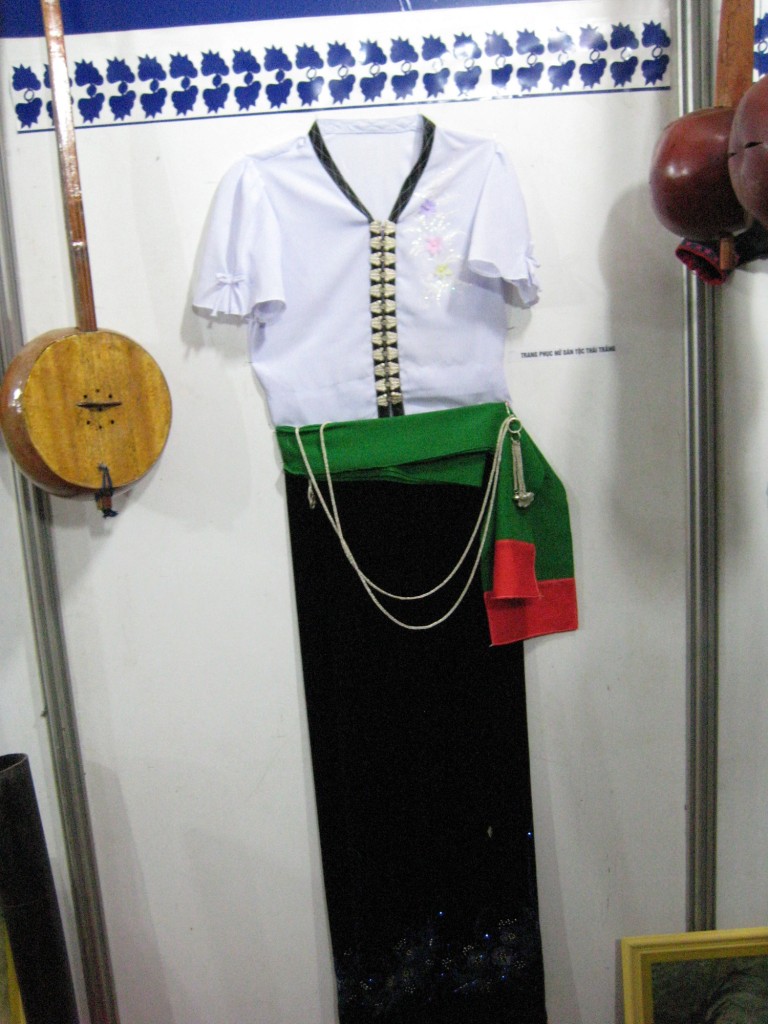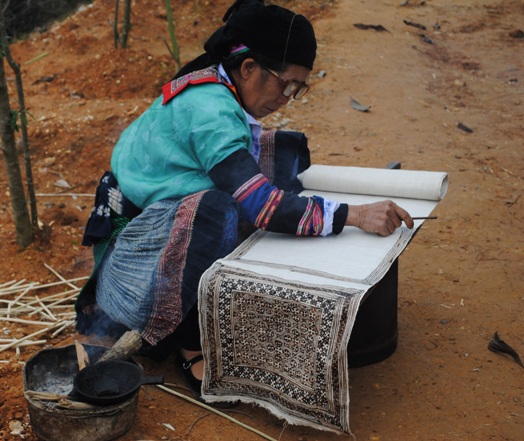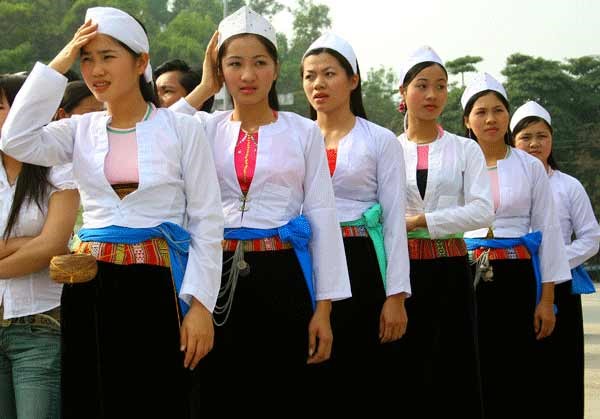“Ao Dai” of the Viet is already very famous and well-known all around the world for its pure and feminine beauty. So in this article, we will concentrate on introducing the traditional costumes of another ethnic group in Vietnam.
Vietnamese Traditional Houses
Across the country, there are 54 groups in total. This number promises a large volume of content even we only talk about their clothes. Therefore, we will choose the representative groups in each region or groups whose costumes have special or unique features and cultural meanings.
All the groups mentioned below still make and wear their costumes occasionally and even daily. You can easily recognize each group’s identity, each person’s status just by the clothes they wear or how they tie their hair.
Thai – Muong (North)

The Thai is the second largest ethnic group in Vietnam (only after the Viet) with two main branches which are Black Thai (Son La, southern Lai Chau) and White Thai (Hoa Binh, northern Lai Chau and Lao Cai). Thai costume is widely recognized and loved, especially the female dress which radiates a feminine, elegant and authentic beauty. The traditional costume of a Thai woman includes a close-fitting short blouse (xửa cỏm) or long blouse (xửa chái, xửa luổng), black long skirt (xỉn), belt (xài cỏm), headscarf (piêu), hat (cúp) and ornaments. The blouse, the skirt and the headscarf are the most important and are even praised in poems and songs. The women even have a special accoutrement called “xài yêu” which is in fact a cloth belt they use from childhood in order to make their waist thinner.
The short blouse is often in a plain colour, can be white, pink, or blue, and has two rows of silver buttons down in the front. Numbers of these buttons also have their meanings: even number is for single girls while the odd number is for married women. Each button is shaped into a butterfly. One row is filled with female butterfly-shaped buttons and the other with male butterfly-shaped ones. There is even a love story related to the origin of the two-button rows on the “xửa cỏm”.
The black skirt “xỉn” covers from the woman’s abdomen, right under the belt to cover her ankles. This dress makes the costume even more graceful and feminine. Thick black velvet skirt is often worn on occasional events together with many other ornaments.
Muong ethnic is close to Thai ethnic and this can easily be seen in the traditional costume and the house of both groups. The first thing to differentiate the Muong from the Thai is the small plain white rectangle scarf they wear on the head, called “Mũ”. The second thing is the overall blouse called “áo pắn”. Thai blouse can be both short-sleeved and long-sleeved but Muong blouse is always long-sleeved. And the Muong blouse doesn’t have button rows in front. Their shirt is shorter, often unbuttoned or just buttoned with one pin at the bottom. The coverall blouse is in white or light pink. Inside, they wear a coloured camisole shirt with the high waistband of the skirt up to the chest. This high waistband is carefully weaved and made with typical brocade patterns. They also wear green cloth belt and silver ornaments. The skirt is named Wẳl, always in a black, tube-shaped and covering from the waist down to the ankles. Muong female costume emphasizes on the feminine, elegant and pure beauties of the women.
H’Mong (North)
H’Mong people have many branches therefore their traditional costumes also are very diverse with different colours and patterns. Almost H’Mong groups in Vietnam inhabit in mountainous areas such as Ha Giang, Lao Cai, Lai Chau, Son La and more. H’Mong people are the 8th largest minority group in Vietnam, living in 62 out of 63 cities/provinces. North Vietnam is where you can find most of the H’Mong groups including red, black, white and more.
The female skirt is the same in every branch of H’Mong with a truncated cone shape, circular folds and many colourful brocade patterns, especially at the hem of the skirt. The shirt is always long-sleeved, also patterned with a lot of colours and details. A belt can’t be missed in an H’Mong traditional costume which is 7 cm wide and 2 meters long. This piece of clothing is decorated with eye-catching textures. The women wear this belt to make their waist look smaller and their figure more elegant. They wear either a scarf or hat on the head. Black H’Mong and Hoa H’Mong wear a pair of thick leggings under knees. All clothes of H’Mong are made from linen or flax fibre.
White and Hoa H’Mong: linen, white skirt, unbuttoned shirt, rectangular, square spiral, circular-shaped patterns on sleeves, back, wearing a headscarf.
Black and Red H’Mong: dyeing with indigo plant, black and red shade coloured, using beeswax heated at 500 C to draw floral, square, triangle-shaped patterns on sleeves, chest parts.

Each pattern on the H’Mong traditional costume has its own meaning, mostly emphasized the harmonization between human beings and nature. Extra silver ornaments are worn on festivals, weekly markets and other important events. H’Mong women wear their traditional costume in daily life. You can see that their costume is authentic, colourful yet so comfortable for hard-working and hiking for long distances….
Dao (North)
Dao people originated from China, is an official minority group in Laos, Myanmar, Thailand and Vietnam. In Vietnam, Dao population is bout under 1 million, mostly inhabited in mountainous areas like Cao Bang, Ha Giang, Lao Cai, Yen Bai, Lai Chau, Tuyen Quang, and few delta regions like Phu Tho, Vinh Phuc and Hoa Binh. There are numerous smaller groups of Dao people such as Red Dao, Dao Quan Chet (Tight Pants), Dao Thanh Y, Dao Ao Dai (Long Blouse), Dao Quan Trang (White Pants).
The traditional costume of Red Dao is the most famous one with the vivid red-coloured headwear, indigo or black trousers and tunic, clothe belt and ornaments. There are 5 colours needed in making a traditional Red Dao costume but red is prominent. With female costume, the most important piece is the long indigo or black tunic with highlighted brocade patterns in front or on cuffs. The blouse divided into 4 parts reaches to mid-thigh, accompanied by a belt with many different coloured tassels. Red Dao women also wear a brassiere with round neck with two traps inside. The patterns and designs embroidered composed of coloured rectangles, squares, Wan script, canarium fruit, sun or stars. The trousers often have more patterns decorated than the shirt.
The most eye-catching feature must be the red headscarf which is the first thing distinguishes the Red Dao from other minorities. The headscarf is folded to make it thicker and larger than many other ethnics’ headscarves.
All the textures on a Red Dao traditional costume are totally sewn by hands of Red Dao women and this task takes a tremendous amount of time. Each costume is highly individualized yet conveying a solid cultural message through each decorative pattern. The Red Dao girls are taught from childhood the skills of embroidery and sewing which they will use to attract a husband and to show their values as a wife to her families.
Tay (North)
The traditional costume of Tay people in north Vietnam is well-known for its simple, classic and graceful beauties. One can hardly mistake the Tay for other ethnics because they are one rare group to use all black for their dressing.
Tay traditional costume is often made of indigo-dyed cotton fabric or silk, dressed in a body with a light-coloured belt in the middle, with a black or coloured scarf on the head. The women wear high collared, knee- or ankle-length tunic with two panels at the front and back, buttoned on the right side, quite similar to Ao Dai of the Viet. One or more silver circular necklaces give the costume a classic feel. A Tay costume may or may not have decorative patterns. Even if the patterns are used, they must be very simple only some hem’s and cuffs’ lambrequins with rhombic cells. Tay people use patterns more for their blankets or other brocade products.
Bru – Van Kieu (Central)
Bru – Van Kieu Group inhabits at 3 Indo-china countries that are Lao, Vietnam and Cambodia. In Vietnam, the population of Bru – Van Kieu is about 80,000 individuals located mostly at mountainous areas of Quang Tri, Quang Binh, Dak Lak and Thua Thien Hue. The people live mainly farming and fishing. The name Van Kieu is the name of the mountain where the first Bru-Van Kieu people villages were set. They have their own language and way of life.
In the past, Bru – Van Kieu did not plant cotton to make clothes on their own but collected the barks of “a nưng” trees to sew basic clothing. Nowadays, the minority has improved their traditional costume which still keeps its authenticity and yet is more convenient for daily life.
Bru – Van Kieu women wear long skirt reaching under the knee about 20-25 centimetres. The Ada shirt is buttoned, long-sleeved, indigo dyed, decorated with brocade pattern and silver at the button row, neckline, and hem. Women also wear a headscarf named “Dam” on special occasions like weddings, funerals and festivals. The scarf is 1 meter long, bright coloured, with fringing at two ends, circled around the head.
Gia Rai (Central Highlands)
Gia Rai is one of the main groups in the Central Highlands of Vietnam, together with Ede, Sedang and Bana groups. They are located mostly at Gia Rai, district Gia Rai, a small amount at Daklak and Kontum. traditional costume, like many other groups’, is made of cotton, dyed with natural trees like indigo, barks of Tơ nung trees. The red colour is most prominent in a Gia Lai traditional costume, also made from natural trees or fruits. They use red at the hems of a shirt and skirt, cuffs, neckline. Gia Lai people think that the black colour stands for soil and earth while the red colour of the patterns represents passion and ambition. The skirt used for women is long, tube-shaped and made from a large clothe wrapping around the body and tied under the belt. The shirt is short, long-sleeved or sleeveless and has the same pattern with the skirt.
Bana (Central Highlands)
Bana group resides mostly at Gia Lai, Kontum, Phu Yen, Binh Dinh, Daklak and Binh Thuan. Bana people have different names in different regions. Their culture is also diverse.
Bana traditional costume of both men and women is made using three main colours that are yellow, red and black. Red stands for strength and love. Black represents the power of nature while yellow hope and dream. Black is favoured and worshipped. All the colours are made from different natural plants or leaves.
A Bana woman is to make her own attire around the age of 14 or 15. The shirt is sleeveless, patterned at neck-line and hem. The tune-shaped skirt reaches just under knee few centimetres. The pattern is arranged on straight horizontal lines, coloured mostly by red and yellow. They also wear small red headband on festive occasions.
Cham (South)
Cham people are very distinguishable from other ethnic groups in the south. They follow loosely Sunni Islamism and Hinduism; have own language, culture and way of life. The origin of Cham people is very close to the Austronesian branch. In the past, Champa used to be an independent empire and perished in the 15th century. Nowadays, they reside mostly at the Binh Thuan, Ninh Thuan, Tay Ninh, Dong Nai, An Giang and Ho Chi Minh city. Cham people still use their traditional costume daily.
Women wear long coloured tunic called “ao dai” reaching to over the knee (same name with Ao Dai of the Viet) with a tube dress, talei kabak (a kind of sash), talei ka-in (waist belt), headscarf, ornaments. The “ao dai” is also in a tube shape and the skirt is often worn in the same colour. In the past, young girls wear white skirts while married women wear black ones. The patterned sash and belt are always made in bright colours like red or yellow. Women use head-scarf on sunny or cold days only. Earrings and necklaces are usually for older women; especially the earrings with 10cm long red fringes are often worn in festive occasions.








